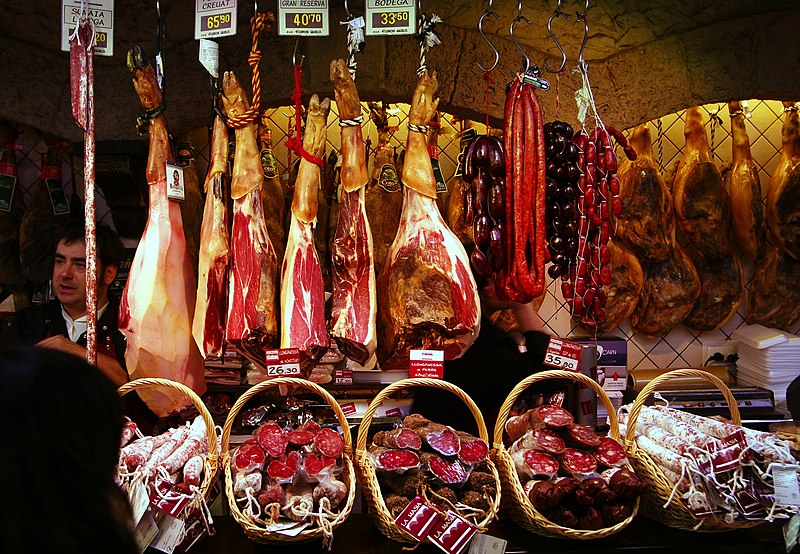Downloads:

General information
Sweets
Red meat
Fats
Keywords
Sweets, red meat, fats, sausages, sugar, occasional consumption, moderate consumption, less recommended
Level
General information
These food groups should be consumed optionally, occasionally and in moderation. Foods of a different nature, which provide energy, but with a high sugar or fat content.
Sweets
Sweets. Including cakes, pastries, industrial pastries, confectionery and ice cream, provide rapidly absorbed sugars and sometimes also fats that are considered unhealthy. Therefore, their consumption should be occasional and sporadic, from time to time as part of a balanced diet, with a maximum limit of two portions per week. Made with several or some of the following ingredients: flour, sugar, honey, eggs, butter or lard, chocolate, dairy products, etc.
Red meat
Red meat, on the other hand, contains saturated fats and should be limited to a maximum of two servings per week. Red meat includes beef, veal, beef, horse meat, some parts of pork and game meat. This includes meats processed with red meat, which are those that have been transformed by salting, curing, fermentation, smoking or other processes to improve their flavour or preservation. Main products include: sausages, sausages, ham, preserved or cured meat, as well as canned meat and meat and sauce preparations.
Fats
Types of fats:
Saturated fats. These are saturated fat molecules with hydrogen molecules. They are found in: red meat, poultry with skin, butter, cheese, whole milk, fried foods. Vegetable oils, such as palm oil and coconut oil. A dietary pattern should be followed in which no more than 5% to 6% of calories come from saturated fats, about 13 grams per day.
Trans fats. There are two types, natural and artificial. Natural fats come from animals or foods made from them. Artificial fats (or trans fatty acids) are the result of an industrial process in which hydrogen is added to liquid vegetable oils to make them more solid: fried foods, cakes, pastries, dough, biscuits, frozen pizza, biscuits, margarines.
Monounsaturated fats. Oils containing monounsaturated fats are usually liquid at room temperature, but begin to turn solid when cooled. Foods such as liquid vegetable oils: rapeseed, olive, sesame or foods such as avocados or nuts.
Polyunsaturated fats. These are fat molecules that have more than one unsaturated carbon bond in the molecule. Olive oil is an example.
All fats provide 9 calories per gram, monounsaturated and polyunsaturated fats can be good for your health, when eaten in moderation. Bad fats (saturated and trans fats) can be detrimental to health.
Description
These food groups should be consumed optionally, occasionally and in moderation. Foods of a different nature, which provide energy, but with a high sugar or fat content.
Labels
Benefits
Sweets are made from rapidly absorbed sugars, such as sucrose, glucose, fructose and honey, provide energy and increase the palatability of food and drinks. Due to the glucose content, they help to enhance activity when feeling tired. The brain is able to take up to 20% of what is consumed. Its consumption is vital to replenish glycogen stores. But it is better to avoid excessive consumption of refined sugars as fresh fruits, dried fruits such as dates, sultanas, dried apricots, prunes and smoothies are healthier options.
The recommendation made by the World Health Organisation is to consume unprocessed red meat at least once a week. The recommended amount of meat is between 100 and 150 grams per serving up to a maximum of 500 grams per week. Meat proteins provide a lot of nutritional quality: vitamin B12, zinc, iron and amino acids important for the formation of new tissues. Eating this type of meat has positive effects on the heart and depression and helps cognitive function.
Consume healthy fats instead of unhealthy fats. Olive oil is the main source of fat in the Mediterranean diet. It provides monounsaturated fats that reduce total cholesterol and low-density lipoprotein (or "bad") cholesterol levels. Nuts and seeds also contain monounsaturated fat. Omega-3 fatty acids help lower triglycerides, reduce blood clotting and the risk of stroke and heart failure. Oily fish, such as mackerel, herring, sardines, tuna and salmon, are rich in omega-3 fatty acids.
Representative Products
Typical European sweet products.
Chocolate. Switzerland, Belgium and Italy (in the Pisa region), although not cocoa producers, are the best chocolate producers.
Italian ice cream, dense and creamy with nuts and fruits.
Honey. Strandzhanski manov med with PDO from Bulgaria, honey from the Alcarria in Spain (Guadalajara).
Cane sugar from Motril (Granada, Spain)
Red and cured meats.
Spain. Beef from Avila, Salamanca. Lamb: Lechazo de from Castilla León, ternasco from Aragón, cordero Segureño (Granada). Suckling pig from Castilla. Cured meats, cecina de from León PGI.
Iberian ham from Andalusia: Jabugo (Huelva), Los Pedroches (Córdoba).
Italy. Sausages such as Bresaola and Culatello.
Portugal: Iberian Ham Barrancos.
Representative fats.
Avocado from Axarquia (Malaga) Fruit with fats rich in omega 3
Butter from Soria (Spain)
Echiré butter (France)
Olive oil from Andalusia, Picual and Hojiblanca varieties in Spain.
Oil from the Puglia region in Italy.
Oil from the Peloponnese and Crete in Greece.
Risks
Reducing red meat consumption to a maximum of two or three times a week and increasing vegetable intake can help prevent some cancers.
Overweight and obesity can lead to certain diseases such as hypertension, stroke, cancer and diabetes, so avoid highly processed products high in fat and sugar.
The consumption of trans fats increases the risk of developing heart disease and stroke. It is also associated with an increased risk of developing type 2 diabetes.
High consumption of sweets can promote overweight and tooth decay.
Further references
Webgraphy in English:
https://www.nhs.uk/live-well/eat-well/meat-nutrition/
https://www.bbc.com/news/health-47057341
https://www.masterclass.com/articles/10-types-of-meat-their-benefits-concerns-and-how-to-cook-each
https://www.tasteatlas.com/100-most-popular-meat-products-in-europe
https://europeisnotdead.com/european-sweets/
 Play Audio
Play Audio

